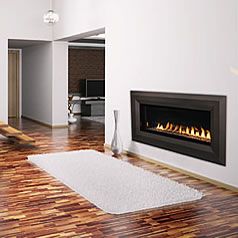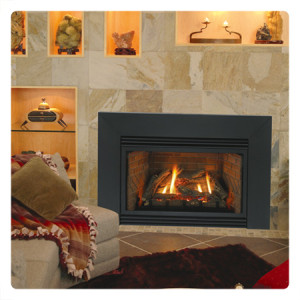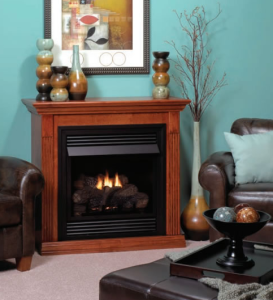As the name would imply, ventless gas appliances, such as fireplaces or gas logs, operate  without the necessity of any sort of vent. Requiring no chimney or flue, ventless appliances can be placed in essentially any room of your home, which makes them extremely convenient to install. And because no heat from a ventless appliance escapes to the outside, all the usable energy stays in the space, cutting down on heating bills during cold winter months.
without the necessity of any sort of vent. Requiring no chimney or flue, ventless appliances can be placed in essentially any room of your home, which makes them extremely convenient to install. And because no heat from a ventless appliance escapes to the outside, all the usable energy stays in the space, cutting down on heating bills during cold winter months.
Since these appliances require no ventilation, some customers have expressed concerns regarding safety and indoor air quality. Fortunately, we can confidently say that ventless gas appliances are not only highly efficient but also extremely safe to use.
How It Works
The vent-free system works relatively simply. The “fire” consists of natural gas, propane, alcohol-based gels, and electricity. It burns at optimum efficiency in order to reduce the production of moisture and carbon dioxide for a well-ventilated room.
Safety Features
In order to ensure reliable operation, federal agencies heavily regulate the use of vent-free appliances. Within vent-free appliances is an exclusive system that detects oxygen levels and adjusts the appliances accordingly—low oxygen levels cause the flame to extinguish. This system, referred to as the Oxygen Detection Pilot System, is tamper-resistant. Any attempt to modify or tamper with the system will immediately disarm any gas supply, as well as the ignition service. Other safety features every vent-free appliance comes equipped with include:
• An automatic shut-off valve (triggered if the flame is disturbed, altered or extinguished in any way)
• A regulator that prevents over-firing if gas pressure were to increase
• An ignition that eliminates the use of matches or lighters
• Safety grills for fireplaces, gas logs and heaters
• Temperature regulator
Indoor Air Quality
In regard to carbon monoxide and oxygen levels, a federally funded independent research study on vent-free products concluded that CO emissions from vent-free gas products are well within nationally recognized indoor air quality guidelines, even for sensitive populations. In recent years, there have been several questions as to whether ventless appliances contribute to extensive moisture that causes mold growth. Again, a federally funded independent research study showed ventless appliances do not generate enough water to raise humidity to a level high enough to cultivate mold-growth. (In fact, water vapor from ventless appliances may even improve air quality for individuals who experience sinus issues in cold weather. Read our water vapor blog to learn more!)
Consumer Safety
At Fine’s gas, our number one priority is customer safety and satisfaction. There are a few steps to consider when investing in any sort of appliance that emits heat, vented or not. First and foremost, all homes—whether they have ventless heating appliances or not—should have a carbon monoxide detector. If you are considering investing in heating appliance, be sure it fits the area you are planning to put it in, and take note of its relation to drapes, walls, furniture, etc. Finally, always seek the help of a professional. Installing a heat source is not a do-it-yourself project.
Fine’s Gas provides reliable experts to walk you through any purchase and answer any question you may have. For more information on our products and services or to find out about the installation process, contact us today!



